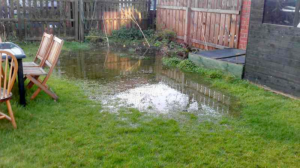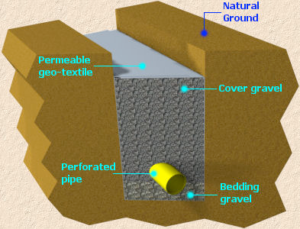If your garden becomes waterlogged after heavy rain, it may benefit from some kind of drainage solution. Without too much effort, a garden land drain, soak away or other form of drainage can remove standing water and prevent your garden from becoming a waterlogged marsh. Proper drainage can also prevent problems with damp both inside your home and can also prevent damage to masonry and brickwork.
PMB SERVICES CAN SUPPORT ALL YOUR REQUIREMENTS IN THESE SITUATIONS
Water, Water Everywhere.. Please Go Away……
Water is essential for life, but too much water can cause many problems in our gardens. Not only does it spoil the appearance of our maintained outdoor living spaces, but excess water can also cause root rot and diseases among trees, plants and flowers.
Does your garden turn into a wetland after heavy rain? If so, it may be a sign that your garden is in dire need of some kind of drainage system.
What a waterlogged garden looks like, how to find out if yours is retaining too much water, and what you can do about it.

Do you have a waterlogged garden?
Is this your problem?
Common Causes of Poor Drainage.
There are many possible reasons why your garden isn’t draining water properly. Here are some of the most common causes of your garden’s swampy appearance:
- Your garden has an uneven surface that allows excess water to form puddles.
- The level of the natural groundwater under your garden is too high to allow easy drainage.
- Your garden is situated at the bottom of a hill or on a lower elevation than surrounding properties.
- Your garden has a paved driveway, patio or another impermeable surface that interferes with water drainage.
- Your neighbor’s garden has a drainage system OR higher garden height that diverts water into your property.
- The guttering of your house is blocked or not connected to a drainage system.
- Your house and garden may have been built on top of a heavy clay layer. This is common in the UK and Ellesmere Port is typical.
- You or your neighbors may have built a home extension, or other structure with foundations that are deep enough to divert water.
How to check if your garden has poor water drainage
Before investing time and money into drainage solutions, we strongly encourage you to confirm that your garden indeed has trouble draining water. Here’s an easy test:
- Dig a hole into the soil approx. (2 feet) deep;
- Fill the hole with water and leave it for six hours.
- If the water is still there.. then it’s a good sign that you need drainage.
Types of Garden Solutions
Before digging up your garden, plan ahead. The first thing to think about is when to do it. We recommend this work is carried out late summer or autumn.
The next step.. Where does the water need to go? You’ll need to locate a ditch, or soak away to redirect your excess garden water there.
Check with your council that you can direct water into the sewerage drain.. CHECK FIRST.
Normal Ditches
Find a slope and dig the ditches (3 feet) deep. The ditches should feature sloping sides and should be dug out at the lower end of the slope.
French Ditches
A French ditch or dry well is a sloped ditch that redirects stagnant water into a drain. They are usually around 15cm (6 inches) wide and 30cm (12 inches) deep.
- Find a slope and dig a horizontal trench across its length in the direction of the drain.
- Use a string and a string level to adjust the slope of the trench and check it constantly.
- Line the trench with landscape fabric for improved water percolation.
- Fill the bottom of the trench with gravel and fold the fabric over it.
- Add gravel on top of the fabric and make sure to spread it evenly to preserve the slope.
- Cover the ditch by evenly distributing topsoil across its entire length.
Land Drains
As with a French ditch, this also involves digging out a sloped trench, lining it with landscape fabric, and filling it with gravel. But here, you will also need to buy and install perforated plastic or corrugated land drain pipes inside the ditches.
Why would you want pipes with holes in them when you could go with a regular non-perforated one? If you have only one spot where water forms a puddle after rainfall, then this method is probably not for you. But if your soil is uneven and you have several spots, then perforated drainage is the way to go.
Because the pipes are perforated, water will get inside from every angle and will be more easily distributed. It’s important to remember that the holes need to point down. Otherwise, the water needs to fill the entire ditch before it can reach the holes.
It’s worth saying that designing and installing piped drainage systems is a big job and should only be handled by certified landscapers.

REMEMBER THIS
Fixing a waterlogged garden is not impossible, nor should it break the bank. But it can do wonders for the appearance of your garden during periods of heavy or persistent rain. You just need to do a bit of careful planning, and the solution will depend on what is causing the flooding, and how severe a problem it is.
For only slight or occasional waterlogging, you may think that creating ditches or installing pipe drainage is too much effort. In these cases, you can help reduce excess water from affecting your garden by picking the right plants.
In fact, one of the easiest and cheapest garden drainage solutions is to plant vegetation that is compatible with your soil type. For instance, some Hydrangea species are great for regulating wet soils, while clay soil gardens will benefit from species like Geranium and Fuchsia.
PMB SERVICES can help you with all your Services give Paul a call TODAY | 07921 466 078
